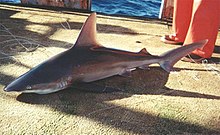Sandbar shark
This is an old revision of this page, as edited by Pinethicket (talk | contribs) at 16:04, 18 May 2012 (Reverted edits by 173.166.162.225 (talk) to last version by Helpful Pixie Bot). The present address (URL) is a permanent link to this revision, which may differ significantly from the current revision.
| Sandbar shark | |
|---|---|

| |
| Scientific classification | |
| Kingdom: | |
| Phylum: | |
| Class: | |
| Subclass: | |
| Order: | |
| Genus: | |
| Species: | C. plumbeus
|
| Binomial name | |
| Carcharhinus plumbeus (Nardo, 1827)
| |

| |
| Range of the sandbar shark | |
The sandbar shark, Carcharhinus plumbeus, is a species of requiem shark, family Carcharhinidae, native to the Atlantic Ocean and the Indo-Pacific. It is distinguishable by its very high first dorsal fin and inter-dorsal ridge.[2]

The sandbar shark is also called the thickskin shark or brown shark. It is one of the biggest coastal sharks in the world, and is closely related to the dusky shark, the bignose shark, and the bull shark. Its dorsal fin is triangular and very high. Sandbar sharks usually have heavy-set bodies and rounded snouts that are shorter than the average shark's snout. Their upper teeth have broadly uneven cusps with sharp edges. Its second dorsal fin and anal fin are close to the same height. Females can grow to 2/2.5 m, males up to 1.8 m. Its body color can vary from a bluish to a brownish grey to a bronze, with a white or pale underside. Sandbar sharks swim alone or gather in sex-segregated schools that vary in size.
The sandbar shark, true to its nickname, is commonly found over muddy or sandy bottoms in shallow coastal waters such as bays, estuaries, harbors, or the mouths of rivers, but it also swims in deeper waters (200 m or more) as well as intertidal zones. Sandbar sharks are found in tropical to temperate waters worldwide; in the western Atlantic they range from Massachusetts to Brazil. Juveniles are common to abundant in the lower Chesapeake Bay, and nursery grounds are found from Delaware Bay to South Carolina. Other nursery grounds include Boncuk Bay in Marmaris, Muğla/Turkey[3]

Natural predators are the tiger sharks, and rarely great white sharks. The sandbar sharks prey on fish, rays, and crabs.
Sandbar sharks are viviparous. The embryos are supported in placental yolk sac inside the mother. The female has a triennial reproductive cycle and give birth to an average of 8 pups. They carry the young for 1 year before birth.
See also
References
- ^ Template:IUCN2006
- ^ Ferrari, A. and A. (2002). Sharks. New York: Firefly Books. ISBN 1-55209-629-7.
- ^ [1]
- "Carcharhinus plumbeus". Integrated Taxonomic Information System. Retrieved 23 January 2006.
- Froese, Rainer; Pauly, Daniel (eds.) (2005). "Carcharhinus plumbeus" in FishBase. 10 2005 version.

